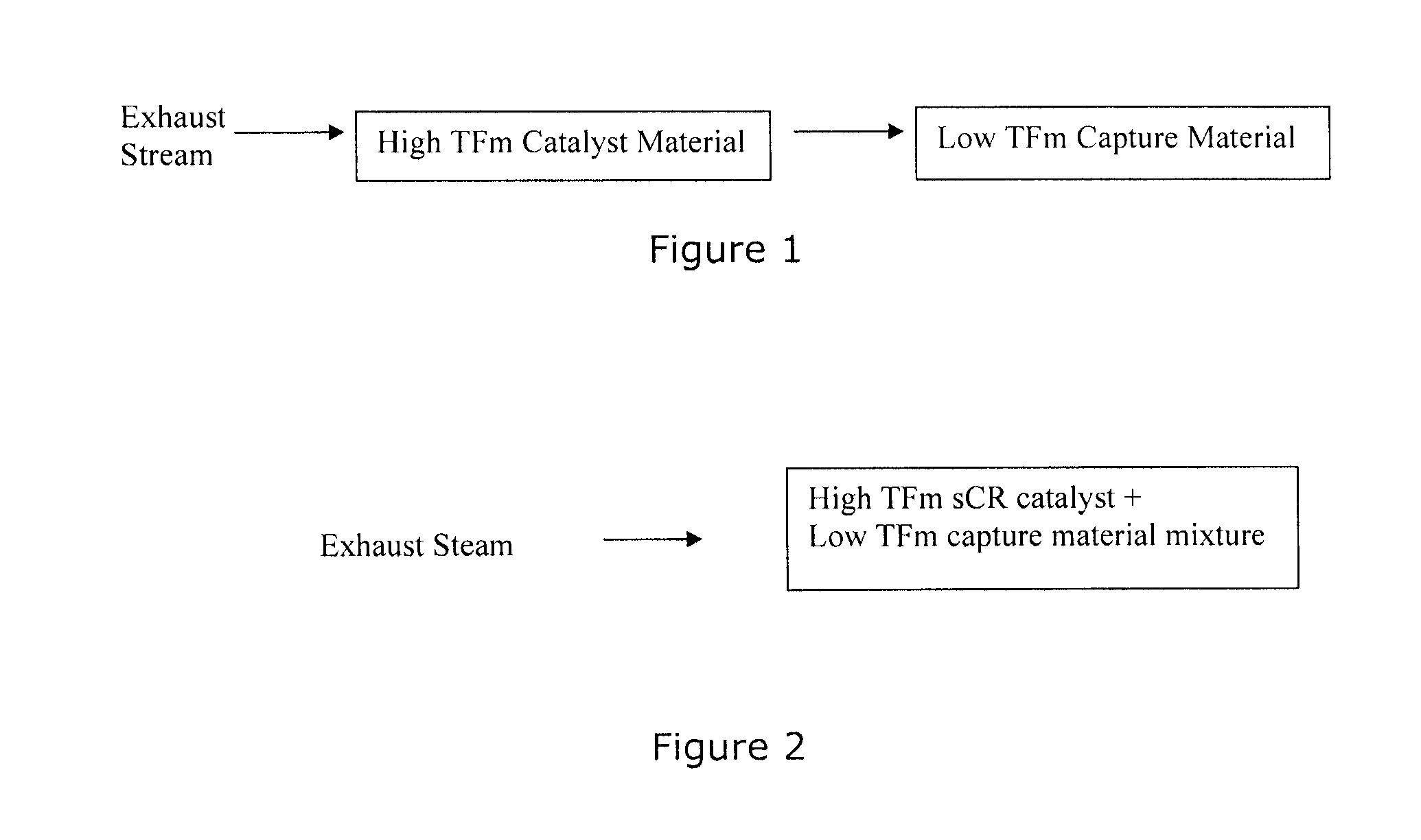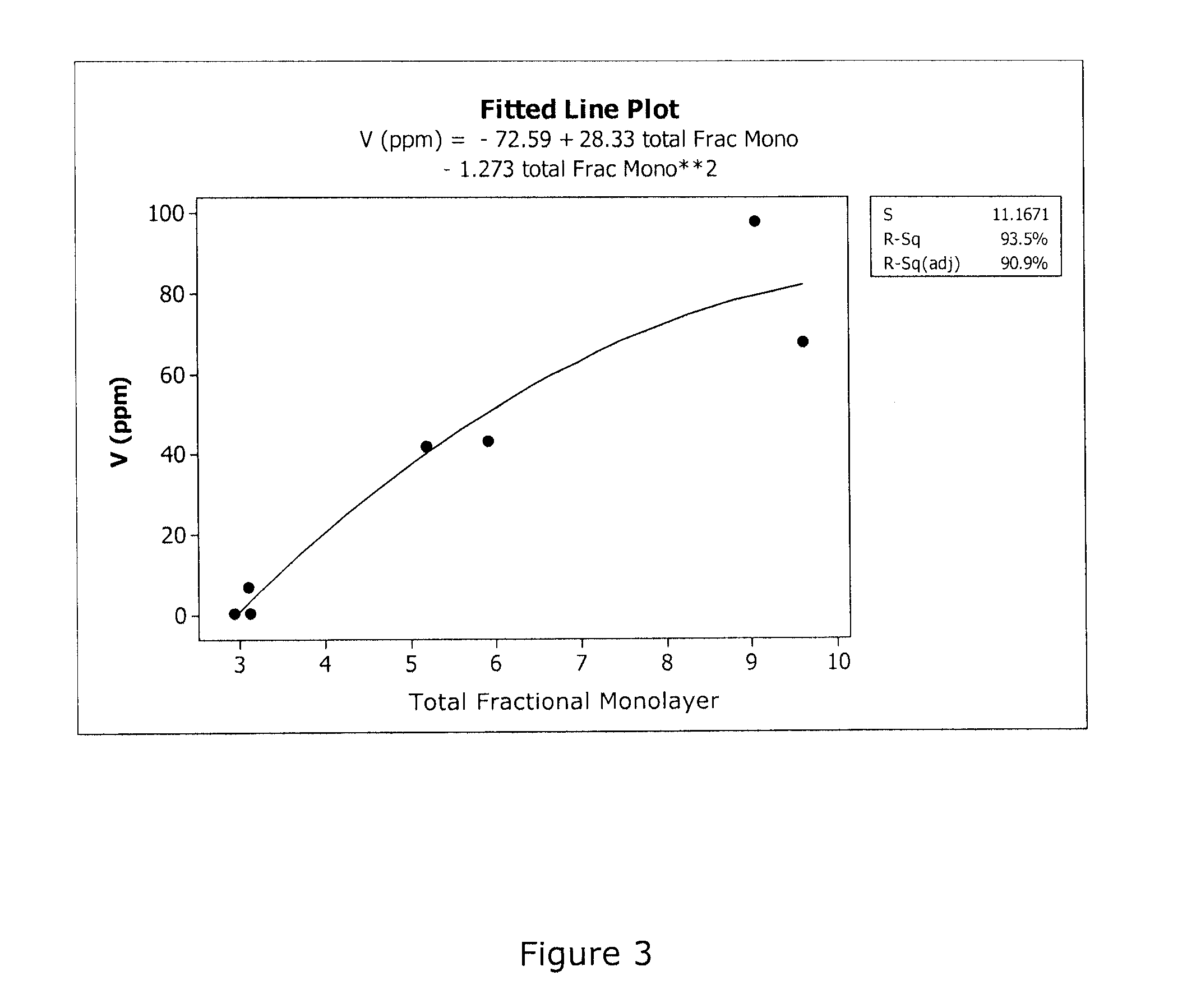Capture of volatilized vanadium and tungsten compounds in a selective catalytic reduction system
a technology of volatilized vanadium and tungsten compounds, applied in the direction of metal/metal-oxide/metal-hydroxide catalysts, machines/engines, arsenic compounds, etc., can solve the problems of potential toxicity, on-road use, and inability to approve vanadia-based catalysts, so as to reduce or eliminate the volatility of catalyst components, reduce volatility, and reduce the effect of density
- Summary
- Abstract
- Description
- Claims
- Application Information
AI Technical Summary
Benefits of technology
Problems solved by technology
Method used
Image
Examples
example 1
Mass Balance
[0026]In this example, the use of a catalyst material comprising DT-52 with 2 wt % vanadia (prepared by evaporation of an alkaline monoethanolamine / vanadia solution) was held in a position upstream of a capture bed, in tests to demonstrate that the volatile components from the catalyst sample could be quantitatively captured by the downstream bed. The DT-52 support is commercially available from MIC, and has a composition of 90% TiO2, 10% WO3. A gamma alumina (Alfa Aesar, aluminum oxide, gamma, catalyst support, high surface area, bimodal) was used as the capture bed material and was additionally calcined at 800° C. for 6 hr in air, and had a nominal surface area of 200 m2 / g. A small quantity, 0.2 g of −14 / +24 mesh, of the alumina was placed in a reactor tube in a position downstream of the catalyst sample. The alumina capture bed was separated from an equivalent amount (0.2 g) of −14 / +24 mesh of the catalyst sample by a short (2 / g, while the surface area of the exposed ...
example 2
Demonstration of Stability of Capture Material
[0030]This example demonstrates that once the tungsta and vanadia are present on the surface of the highly stable, high surface area capture material (in this case, gamma alumina) they are not volatile under the test conditions, even at exceedingly high exposure temperatures. Thus, a gamma alumina sample (Alfa Aesar, aluminum oxide, gamma, catalyst support, high surface area, bimodal) was loaded with 47013 ppm W and 11200 ppm V (by deposition from alkaline monoethanolamine solution) and subsequently calcined at 600° C. for 6 hr in air. This catalyst sample was positioned upstream of a downstream capture material (un-doped gamma alumina) as in Example 1. Separate tests demonstrated that the surface area of the W and V-doped alumina was 191 m2 / g after exposure at 750° C. for 16 hr in an atmosphere that contained 10% H2O, which demonstrates the high stability of the material. The catalyst and capture materials were then exposed to the react...
examples 3 through 7
Evaluation of Various Vanadia-Based of Catalyst Materials
[0031]The discoveries described in Examples 1 and 2 presented a method of the present invention as a means to investigate the volatility of various catalyst components such as V and W at the laboratory scale. Thus, in the following examples, SCR catalysts that contain tungsta and vanadia supported on various titania-based supports, were screened for the volatility of the catalyst components. The materials in these Examples all contained 2 wt % V2O5, deposited from alkaline monoethanolamine solution, and the V-doped materials were calcined at 600° C. for 6 hr in air to remove the water and organic components. The DT-58 base material is a commercially available titania-based SCR catalyst support available from MIC. The composition of the DT-58 support is 81% TiO2, 9% WO3 and 10% SiO2. The samples in Examples 5 and 6, labeled MC-X5v1 and MC-X5v2, are developmental SCR catalyst supports as described hereinbelow in reference to “St...
PUM
| Property | Measurement | Unit |
|---|---|---|
| temperature | aaaaa | aaaaa |
| temperatures | aaaaa | aaaaa |
| gas-hourly space velocity | aaaaa | aaaaa |
Abstract
Description
Claims
Application Information
 Login to View More
Login to View More - R&D
- Intellectual Property
- Life Sciences
- Materials
- Tech Scout
- Unparalleled Data Quality
- Higher Quality Content
- 60% Fewer Hallucinations
Browse by: Latest US Patents, China's latest patents, Technical Efficacy Thesaurus, Application Domain, Technology Topic, Popular Technical Reports.
© 2025 PatSnap. All rights reserved.Legal|Privacy policy|Modern Slavery Act Transparency Statement|Sitemap|About US| Contact US: help@patsnap.com



